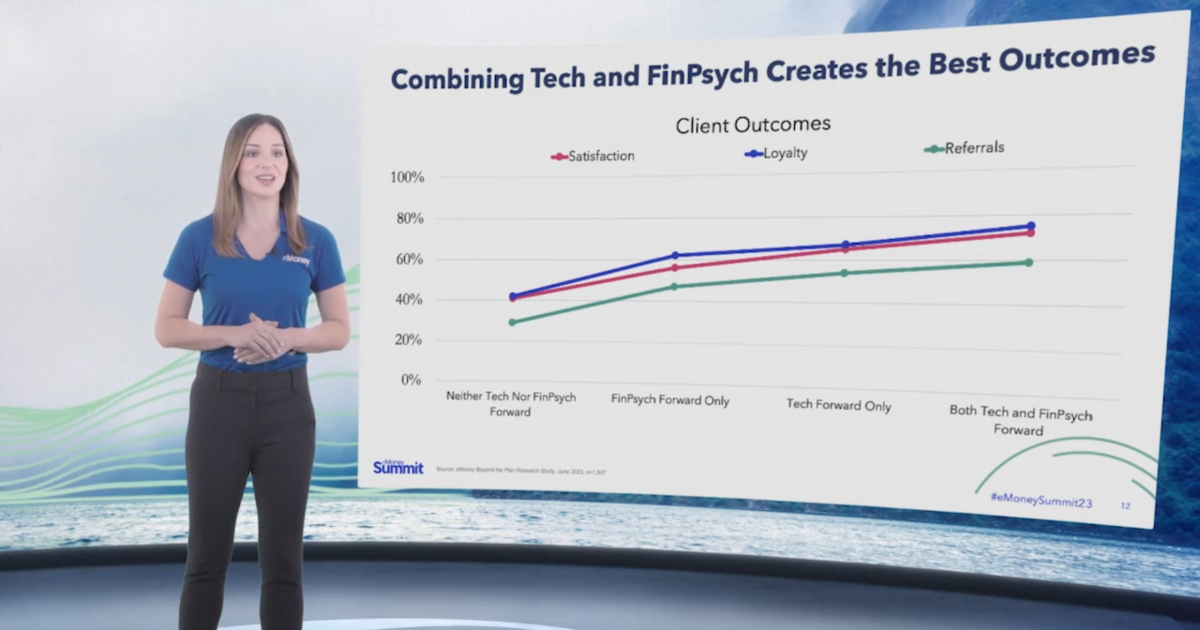[ad_1]
Melissa Ellis recalls the day a new client, who was going through divorce, admitted that she didn’t know how to access her own bank account.
The woman’s soon-to-be ex-husband had financially abused her for years, said Ellis, a certified financial planner and certified divorce financial analyst who is the founder of Overland Park, Kansas-based RIA Sapphire Wealth Planning.
“He had control. And he told her that they can only have one login to their bank account, and she believed that,” Ellis said. “She sat in my office and we created a login to their joint bank account.”
For the first time in years, the woman could see all the statements. “She didn’t know that she could walk into the bank and ask anything of them, because her name’s on the account. I said, ‘You own that account.’ But he had her brainwashed,” Ellis said.

Melissa Ellis
Financial abuse, such as what Ellis’s client experienced, is a leading reason why individuals have difficulty leaving abusive relationships. By controlling someone’s access to money, credit and financial resources, an abusive person can make it near-impossible for their partner to get out. If the abuser leaves, as in the case of Ellis’s client, they can wreck their partner’s financial life in the process.
Yet unlike physical violence, this behavior often leaves no trace. In the case of Ellis’s client, her life seemed perfect on the outside. “She was living in a very nice house in a very nice neighborhood. One of the most elite neighborhoods in the city,” Ellis said.
The woman’s husband spent all her inheritance money, $85,000 she received when her mother passed away. With her limited funds, she was able to win only $25,000 in the divorce, Ellis said, although it appeared she should have gotten $500,000 or more.
One year later, the woman is now renting on her own and starting over. “She has less. But she feels like she has control of her financial situation.”
Financial advisors, who have the rare opportunity to see the inner workings of a household’s finances, can be in a position to help individuals facing abuse or to guide couples away from financially disempowering one person in the relationship, which can make them more vulnerable to abuse and domestic violence.
Domestic violence is a pattern of abusive behaviors used by one person against another in a household or intimate relationship, with the aim of controlling and maintaining power over the abused individual. Among professionals in the field of survivor support services, the term “intimate partner violence” has been used more in recent years to describe domestic violence occurring within a couple or a dating relationship, acknowledging that abuse can also happen in non-intimate or non-romantic relationships, such as between parents and children. Individuals of all ages, genders, races, sexual orientations and wealth levels can be vulnerable to domestic violence, although the existing data shows that most survivors are women.
The nature of abuse varies widely and doesn’t involve only physical violence. Nonphysical abuse includes economic or financial abuse, and like all abuse, it can escalate over time. Even after the relationship ends, survivors can suffer damaged credit, a plunge into poverty or homelessness, and in some cases costly long-term damage to their health.
READ MORE: 6 tips for advisors to help clients plan around gray divorce
Numerous community organizations and nonprofits across the country seek to help survivors, but many report being woefully underfunded — meaning that in practice, an individual seeking emergency support from such groups may find limited services, such as a lack of available beds at the local women’s shelter. Nationwide, on a single night last September, “programs did not have the resources to meet 12,692 requests for services,” according to a 2023 report by the National Network to End Domestic Violence.
While these nonprofits serve on the front lines of reacting to abuse, advisors might be able to play a valuable role in preventing that abuse or in facilitating healing from abuse, experts interviewed for this piece said. An advisor can not only guard families’ inheritances from being seized by an abusive partner, but also help clients on their wealth-building journeys avoid crippling their future selves, and potentially even save lives.
Experts shared several tips with Financial Planning regarding how advisors can better support their clients to avoid or recover from financial abuse.
Correct common misconceptions about abuse
“A lot of advisors and people in general have a myth about the types of relationships that financial abuse occurs in,” said Stacy Francis, a CFP and CDFA who is the president and CEO of RIA Francis Financial in New York City, where she specializes in working with widows and divorced women.

The truth is that abuse can also occur in “ultrahigh net worth marriages,” Francis said. “That is the number one misconception — that this is a problem among the lowest socioeconomic group of individuals. Yet it happens frequently, also among the rich.”
Another misconception is that women, who are more frequently the victims of abuse, are not interested in engaging with the advisor because they aren’t interested in money. “That could definitely be it. But it also might be because they’re being essentially excluded. … Don’t take it at face value that she’s not attending just because she doesn’t want to.”
Unfortunately, many advisors remain unaware of domestic violence, although awareness has improved in recent years, Francis said. “Most financial advisors are trained to love numbers. It’s very rare that you’re going to find a financial advisor that has any training or background in mental health, either coaching or therapy, even fewer around financial abuse and domestic violence,” Francis said. The field itself, still heavily male-dominated, even offers occasional examples of advisors charged with alleged domestic violence.
Francis knows firsthand the tolls of domestic violence. Her grandmother was a victim of domestic violence and was trapped by financial abuse, she said. The experience drove Francis to found Savvy Ladies, a nonprofit whose stated mission is to provide all women with financial education. The organization also serves women who are survivors of abusive relationships, and offers a free series of online courses to help them with “financial abuse recovery.”
“We do have a lot of women who come to us that are being put in financially abusive situations,” Francis said. By offering access to financial planners free of charge, the group aims to help them protect or rebuild their wealth.
Understand why leaving is hard
A common question that survivors of domestic violence tend to get is “Why didn’t you just leave?” The answer can extend beyond financial readiness, but experts in the field of domestic violence cite financial barriers as a big reason. Abusers may have emotionally beaten down their victim so much that they doubt themselves and feel unworthy of better treatment, or come to believe the abuse is their own fault. An advisor whose client is in this position may recommend that the client find therapists specializing in abuse and trauma, or support from a domestic violence services organization, to recover self-worth and drive to leave.
“Often she doesn’t realize that what is happening is actually abuse. … She has been told over and over again, from her abuser: ‘You’re not good with money. That’s why I don’t give you money. You’re not smart enough, you’re not responsible,'” Francis said.
Abuse also often occurs cyclically. Following an episode of abuse, the perpetrator often attempts to apologize and become loving again, giving a victim hope that things will get better, or reason to stay. However, abusers rarely change, and many repeat their behaviors with new partners.
Making things worse, abusers frequently cut off their victim from the rest of the world, leaving them dependent on the abusive partner for their emotional and financial needs, without outside support when things go south. An advisor can provide that outside voice to a client if they sense an individual may be vulnerable to financial abuse.
Finally, leaving can be incredibly dangerous and life-threatening — often considered the most dangerous time in the relationship, according to the National Domestic Violence Hotline, so it shouldn’t be undertaken in haste. Survivors ideally should prepare funds for a move to new housing, potential legal costs of a divorce, and a job search, among other expenses.

Luxe Studio Productions
Advisors can also offer financial safety planning to help clients leave — especially by prioritizing the creation of a secret emergency fund for the survivor. “Number one, it’s definitely important to make sure the client has savings built up” so they can leave, said Steve Oniya, the president and chartered financial consultant at OM Investments, an RIA based in Houston. Oniya is a volunteer for Savvy Ladies, where he answers questions from women about finances on a free helpline.
“Make sure that they have three to six months of savings’ worth at a minimum. The more, the better, but that is definitely one strategy so you don’t have the fear of, ‘Oh, they cut me off.'” The advisor should also encourage clients to not put all their money into a joint account with the partner, he said.
Be alert to signs of abuse
The signs of financial abuse can be many and subtle, making it “insidious,” Francis said.
“It starts out just very innocent: ‘You know what, I know you’re busy. I’ll take care of the bills. I know that you don’t enjoy your job. No worries, you can give up your job. You know what, I know that having a paycheck go into your account, you’re getting a little stressed about how to manage it. Well guess what? I will do that, I’ll have it transferred from your account to my account, once it comes in.'” Francis said.
READ MORE: The top 3 financial lies Americans tell their partners
Other warning signs for advisors to be on the lookout for include hidden accounts or debts, Ellis said. “I’ll have clients run a credit report and then go through it and look for accounts that maybe they’re not aware of that are open … in their name,” she said. If their assets are “way lower” than expected for their income, it could be a sign of hidden accounts stashing their income away for one partner or big debts they’re secretly running up, she said.
Financial abuse can sometimes start with one partner persuading the other to leave the workforce and become a stay-at-home parent, according to Chevonne Farler, a wealth management advisor at TBH Advisors, an RIA in Brentwood, Tennessee.

Stephanie Bullock
Farler said that while not all stay-home spouses are at risk of abuse, “it can sometimes open the door for that abuse to start occurring. Where, ‘I make all the money, so you need to do what I say.'” This can lead to one spouse putting the other one on a tight “allowance” to pay all the household bills, Farler said.
Farler recalled a husband who had encouraged his wife to cash out her retirement savings to pay off their mortgage early — only to divorce her a few years later, after cleaning her out. Advisors can prevent this drift over time to one partner managing all the money and accounts by engaging both members of a couple at the outset, Farler said. In the case above, “a financial advisor … could have stopped that from the beginning, going, ‘Wait a second, do you really need to be paying off a 2.75% mortgage?'” Farler said.
Advisors can help parents and children spot the signs of a potentially abusive dating partner. These early warning signs can include love-bombing, where the new partner bombards the person with gifts and affection even after just meeting, and tries to press for commitment very early on; and jealousy and early signs of putting the individual down.
“If a family has money that they’re giving to their daughter, most definitely put it into an account in her name and her name only,” Ellis said, adding that trusts can be the best way to secure such funds.
[ad_2]
Source link




